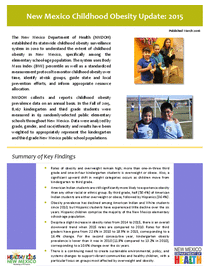Downward Trend in Childhood Obesity in the Last 5 Years
Health Department Releases Yearly Childhood Obesity Update

The New Mexico Department of Health releases its annual New Mexico Childhood Obesity Update each year in March to coincide with National Nutrition Month. There was a slight, but statistically insignificant increase in obesity among kindergarteners and third graders between 2014 and 2015. In 2015, 11.8 percent of kindergarteners were obese, compared to 11.6 percent in 2014. Among third graders, 18.9 percent were obese in 2015, compared to 18.1 percent the year before.
“Based on data this year, we may be seeing childhood obesity rates in New Mexico beginning to level off,” said Deputy Secretary of Health Lynn Gallagher. “We are proud of the progress our Healthy Kids Healthy Communities and partners throughout New Mexico have made to increase opportunities for healthy eating and physical activity.”
While New Mexico is making progress in the fight against childhood obesity, more than one in three third grade and one in four kindergarten students is overweight or obese. There is also a significant upward shift in obesity prevalence between kindergarten and third grade.
In 2010, the Department of Health established a statewide childhood obesity surveillance system, and it has been collecting and reporting childhood obesity prevalence data each year. It uses Body Mass Index (BMI) and a standardized measurement protocol to monitor childhood obesity over time. In 2015, more than 8,100 kindergarten and third grade students were measured in randomly-selected elementary schools throughout the state.
In addition to surveillance, the Department’s Healthy Kids, Healthy Communities (HKHC) program is committed to helping increase opportunities for healthy eating and physical activity. HKHC builds collaborative state and local partnerships to expand opportunities for and exposure to healthy eating and physical activity for children and low-income adults where they live, learn, play, eat, work and shop. Because healthy eating and physical activity are the two major lifestyle choices that can help prevent obesity, HKHC focuses exclusively on policy, systems, and environmental changes to support these behaviors in a multi-sector community coalition-driven approach.
Through more efficient use of federal funding, the New Mexico Department of Health expanded participation in HKHC last fall from nine counties to 18, and from two tribal communities to six. The expansion combined $1 million in federal funding through the Supplemental Nutrition Assistance Education Program (SNAP-Ed) with Healthy Kids New Mexico. With SNAP-Ed funding, the Department of Health and its partners are now able to reach low-income adults in its obesity prevention efforts for the first time.
The HKHC reaches about a quarter of elementary-aged students in the state. The program achieved the following accomplishments in the 2014-15 school year:
- Eighty-eight percent of students in HKHC public elementary schools had increased healthy eating opportunities.
- Seventy-one percent of HKHC public elementary schools had increased physical activity opportunities.
- HKHC leveraged at least $1.8 million to support healthy eating and physical activity initiatives within their communities.
The Healthy Kids Healthy Communities program encourages New Mexicans to take the 5-2-1-O Challenge for 21 days, the amount of time it takes to begin to change behaviors.
- 5 – Eat 5 fruits and vegetables every day.
- 2 – Limit TV and computer use to 2 hours a day, and use the extra time reading books, or learning new hobbies.
- 1 – Get at least 1 hour of physical activity a day.
- O – Drink plenty of H2O every day.
You can visit the Healthy Kids Healthy Communities section of our website for more information about the Challenge, healthy recipes, physical activity ideas and much more. View the full Childhood Obesity Update 2015 publication to learn more.
Media Contact
We would be happy to provide additional information about this press release. Simply contact Kenny Vigil at 505-841-5871 (Office) or 505-470-2290 (Mobile) with your questions.
Versión en Español
En un esfuerzo para hacer que nuestros comunicados de prensa sean más accesibles, también tenemos disponibles una versión en español. Por favor presione el enlace de abajo para acceder a la traducción.
Tendencia A La Disminución En La Obesidad Infantil En Los Últimos 5 Años

